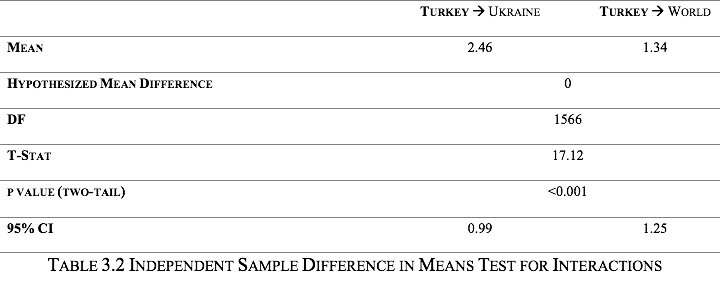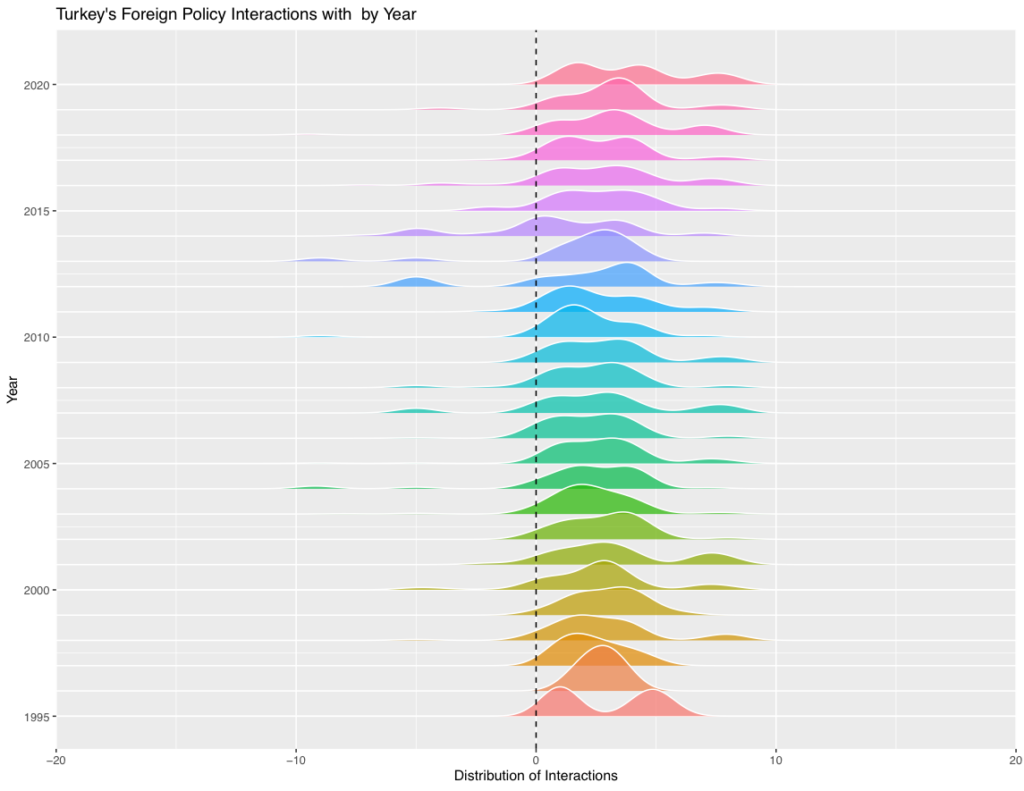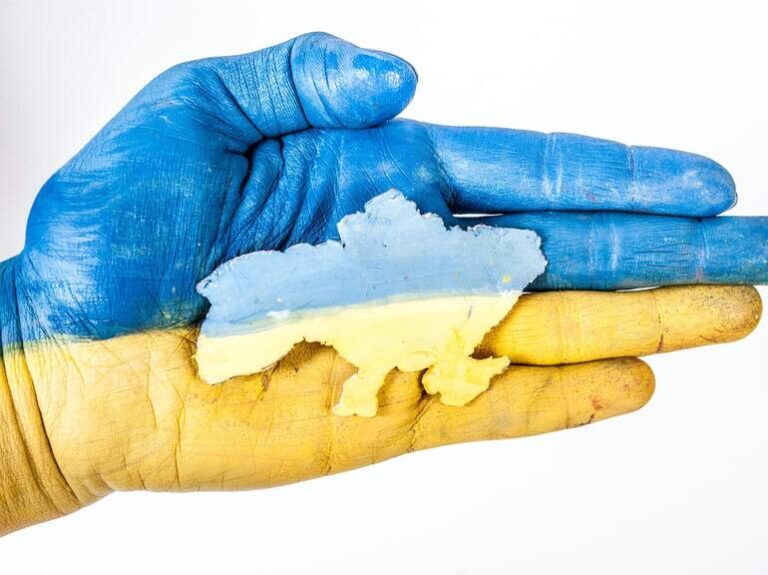An Anatomy of Turkish Foreign Policy: 1995 – 2020, Issue #9: Turkey and Ukraine
Introduction
This study is the ninth bilateral analysis of Turkish Foreign Policy (TFP) in the research project titled: “An Anatomy of Turkish Foreign Policy.” Our goal is to quantify TFP’s evolution between 1995 and 2020 through a data-driven account free of speculative remarks. In this analysis, we will focus on the development of Turkey’s bilateral relations with Ukraine. In doing so, we will begin with a quantitative analysis of the relations to provide an overview. Next, we will survey the notable events between the two countries that impacted bilateral relations.
The Data
We use data from the publicly available Lockheed Martin Advanced Technology Lab’s Integrated Crisis Early Warning System (ICEWS) event database in the present analysis. We discuss the methodology in Issue #1 of this series.[1] In brief, ICEWS features information on directed dyadic interactions between countries (i.e., Turkey and Ukraine), where each observation includes details of who (source) did what (action) to whom (target), when (time), and where (location). Each interaction is then assigned an intensity score that ranges between -10 and +10 based on the category of the interaction. Negative interaction intensity scores imply conflict, and positive interaction intensity scores indicate cooperation. We calculate monthly and annual averages of the intensity scores to form indices.
Turkey – Ukraine Relations: An Overview
How frequently does Turkey interact with Ukraine, and what is the nature of its interactions? In Issue #1 we demonstrate that, Ukraine is among the top thirty partners of Turkey by interaction frequency (ranking 26th). ICEWS features 1510 observations with Ukraine within this timeframe, of which 516 are unique interactions.[2] This number corresponds to slightly below one percent of Turkey’s total interactions of 186,255. TABLE 3.1 below compares the summary statistics of Turkey’s directed dyadic interaction intensity scores with Ukraine and the rest of the World.

The summary statistics in Table 3.1 provides a good overview of the overall interactions’ essence. The higher average intensity score of 2.46 between Turkey and Ukraine compared to the 1.34 between Turkey and the World suggests that Turkey’s relations with Ukraine vis-à-vis the World were, on average, more cooperative throughout the last two and a half decades. This difference can also be qualitatively captured by exploring the shapes of the distributions. Figure 3.1 and Figure 3.2 below are event intensity score distributions. In both distributions, any value to the left of 0 suggests a conflictual interaction and to the right suggests a cooperative interaction. We also include the results of a simple difference-in-means test in Table 3.2, which indicates a statistically significant difference in the average intensity of interactions towards Ukraine compared to the World.

Looking at the relations between Turkey and Ukraine exclusively, the summary statistics from Table 3.1 suggest the instances of cooperation between the two countries were slightly more than instances of conflict, given the negative skewness in the data’s distribution.
What was the variation in the frequency of bilateral interactions over time? Figure 3.3 below demonstrates the frequency of both cooperation and conflict initiations by Turkey toward Ukraine by year. It should be noted that this figure does not take into account the magnitude of cooperation or conflict. Overall, the bilateral relations are defined cooperative interactions. The figure suggests the presence of three phases. The first phase between 1995 and 2005 is marked by gradually growing interaction initiation. The second phase, which spans 2005 and 2014, features a decreasing frequency of cooperative interaction initiations. During this time, the frequency of conflict initiation remains steady and low. The year of 2014 plays a pivotal role as it marks the annexation of Crimea. The final phase extends from 2014 to 2020.


The disaggregation of interaction frequency by intensity over time provides further information. Figure 3.4 demonstrates the annual distributions of interactions. The distribution at the bottom displays the values for 1995 and the one at the top for 2020. As always, while 0 marks neutral events, any interactions that are located to the right of 0 are classified as instances of cooperation, and to the left are instances of conflict. The magnitude of interaction intensity increases as it approaches the minimum and maximum values (10 and -10). The figure remains steady overall until 2014 with most interactions on the right side of the 0 mark. Following the annexation of Crimea amity became the defining characteristic among the parties. Figure 3.5 demonstrates the variation in relations during a given government.[3] The intensity and frequency of interactions with Ukraine are at their highest during the 59th, 60th, 64th, 65th, and 66th governments.
States actively react to signals that they receive from their counterparts and adjust their foreign policy towards them. An index can be particularly useful for understanding the overall evolution of the signals in bilateral relations. Our most noteworthy contribution in this report is the index of bilateral relations between Turkey and Ukraine. We present the index in In Figure 3.6.
To draw our overall dyadic relations index, we begin with calculating a simple monthly intensity average of all interactions for a given month. The values of these averages are displayed with the black dots in Figure 3.6. A dot above zero suggests that the interactions for the month were cooperative, and a dot below suggests otherwise. Next, we move on to the trendlines. An upward-pointing trendline suggests an improvement in the bilateral relations and an increase in cooperation, whereas a downward-pointing trendline suggests growing discord, regardless of its color. We first focus on the short-term trends and calculate a six-month moving average. This line shows the average intensity scores considering the preceding six months and is displayed with the red line in Figure 3.6. This trendline describes the short-term cascades in which the two countries interact with each other. Finally, we turn to the long-term and fit a non-parametric locally weighted smoothing line among all the monthly averages, which is displayed with the blue line in Figure 3.6. The grey band around the blue line shows the 95% confidence intervals. This line captures the trend in the long-term evolution of bilateral relations between Turkey and Ukraine. Parallel to findings above, the line suggests a significant increase in bilateral cooperation following the year of 2014.




Defining Moments in Turkey – Ukraine Relations
What are the momentous events that defined the relations between Turkey and Ukraine? In this section, we focus on the milestones that defined the bilateral relations within the past two and a half decades between the two countries. We use the ICEWS intensity variable for filtering individual milestone interactions.
Armored Personnel Carrier Sales, 16 February 1998
Ukraine offered to sell BTR 80-type military armored vehicles “unconditionally.” The Turkish government opted for pursuing domestic production of the same class of vehicles. [Source]
Defense Industry Cooperation Agreement, 14 November 2000
The Defense Industry Cooperation Agreement between the Government of the Republic of Turkey and the Cabinet of Ministers of Ukraine was accepted by the Grand National Assembly of Turkey and published in the Official Gazette. [Source]
The National Defense Minister’s Visit to Ukraıne, 8 August 2001
Minister of National Defense Sabahattin Cakmakoglu visited Ukraine to discuss defense industry partnership between Turkey and Ukraine. [Source]
The Foreign Affairs Minister’s Visit to Ukraıne, 11 June 2002
Minister of Foreign Affairs Ismail Cem visited Ukraine to strengthen bilateral ties between Turkey and Ukraine. [Source]
The National Defense Minister’s Subsequent Visit to Ukraine, 8 May 2003
Minister of National Defense Vecdi Gonul visited Ukraine to strengthen bilateral ties in defense sector between Turkey and Ukraine. [Source]
The Presidential Visit to Ukraine, 18 June 2003
Turkish President Ahmet Necdet Sezer visited his counterpart in Ukraine to discuss regional issues and bilateral ties. [Source]
Cooperation Agreement in Legal Matters, 9 July 2003
A legal assistance and cooperation agreement in legal matters was signed between the two countries with the will to strengthen the ties of friendship and to carry out mutual legal assistance on legal issues based on the principles of the national sovereignty of both nations. [Source]
Commercial Maritime Protocol, 16 February 2004
The protocol between the Government of the Republic of Turkey and the Cabinet of Ministers of Ukraine, Amending the Commercial Maritime Agreement between the Government of the Republic of Turkey and the Government of Ukraine was approved. [Source]
Cultural and Tourism Agreement, 18 April 2004
The Cooperation Program between the Ministry of Culture and Tourism of the Republic of Turkey and the Ministry of Culture and Arts of Ukraine for the years 2003-2007 was approved. [Source]
NATO-Ukraine Commission Meeting in Istanbul, 24 June 2004
President Ahmet Necdet Sezer hosted heads of state and government from 26 NATO member countries in Istanbul. After the meetings, the US President George Bush held the NATO-Ukraine Commission meeting in Istanbul. [Source]
Transport and Infrastructure Protocol, 30 March 2005
Turkey-Ukraine Land Transport Joint Commission Protocol was approved to initiate further investment in transportation level. [Source]
Executive Level Talks, 17 January 2007
Prime Minister of Ukraine Viktor Yanukovych met President of Turkey Abdullah Gul, where regional and bilateral relations were discussed at the meeting. [Source]
The Leader of the Grand National Assembly Visits Ukraine, 27 June 2008
The Leader of the Grand National Assembly of Turkey Koksal Toptan met with Prime Minister of Ukraine Yulia Tymoshenko. The parties underlined the benefits of cooperation between the two countries. Tymoshenko also emphasized that ongoing reciprocal cooperation is important for both the world and the region. [Source]
Executive Level Talks Continued, 27 October 2008
Turkey’s Prime Minister Recep Tayyip Erdogan hosted Ukraine’s President Viktor Yushchenko in his office in Ankara. [Source]
Visa Agreement, 7 May 2010
The embassy of Ukraine expressed the Turkish side’s positive attitude towards establishing the High-Level Strategic Council between the two countries and signing an agreement that will facilitate the visa procedures. [Source]
Honorary Doctorate to Turkish Prime Minister, 25 January 2011
Prime Minister Recep Tayyip Erdogan was awarded an honorary doctorate at Taras Shevchenko National Kyiv University. [Source]
Negotiations on FTA Between Turkey and Ukraine, 25 January 2011
Turkey and Ukraine formed the formal process for the free trade zone agreement. [Source]
On Crimea, 28 February – 1 March 2014
Following the Russian annexation of Crimea, Foreign Minister Ahmet Davutoglu visited Ukraine and met his counterpart. Davutoglu underlined that Ukraine is Turkey’s strategic partner and Ukraine’s territorial integrity and political unity are the most basic principles in their relationship. [Source]
Turkey Reiterates Support to Ukraine, 19 July 2014
Minister of EU Affairs and Chief Negotiator Mevlut Cavusoglu met Minister of Foreign Affairs of Ukraine Pavlo Klimkin and Leader of the Crimean Tatar Turks Mustafa Abdulcemil Kırmızıoglu. Cavusoglu stated that they reiterated Turkey’s support for Ukraine and underlined that they do not recognize the annexation of Crimea. Parties decided to speed up the process for the entry into force of the free trade agreement between the two countries. [Source]
Turkey-Ukraine High Level Cooperation Council Meeting, 20 March 2015
The fourth meeting of the Turkey-Ukraine High Level Cooperation Council was held in Ukraine with the participation of Turkish President Recep Tayyip Erdogan and Ukrainian President Petro Poroshenko. [Source]
Political Support to Ukraine and the Crimean Tatars, 20 August 2016
Turkish President Recep Tayyip Erdogan reassured his Ukrainian counterpart Petro Poroshenko that Ankara continues its policy on the Crimean Peninsula, which is Ukrainian territory. Erdogan indicated that Ankara would not recognize “Crimea’s occupation” and would continue supporting “the Crimean Tatars in every possible way.” [Source]
Free Trade Agreement Negotiations, 29 September 2016
Vasily Bodnar, Consul General of Ukraine in Istanbul, announced that most of the bureaucratic process on the free trade agreement between the two countries had been completed. He underlined that the entry of many products, including Turkish textile products, into Ukraine will be easier. [Source]
Joint Radar Production Venture, 12 October 2016
Ukraine State Defense Enterprise and Turkey’s Havelsan Air Electronic Industry agreed on joint radar production. The agreement between the two sides was the first joint defense production in their history. [Source]
Altay Tank Engines Manufacturing, 17 May 2017
Ukraine Embassy in Ankara announced that Turkey agreed with Ukraine for the serial production of the Turkey Altay tank engine produced by UkrOboronProm. [Source]
Visa-Free Travel, 1 June 2017
An agreement was signed between Turkey and Ukraine, allowing the citizens of the two countries to make mutual visits with their national identity cards. The first visitor from Ukraine arrived in Ankara in June 2017. [Source]
Ukraine-Turkey Business Forum, 14 July 2017
The Ukraine-Turkey business forum, organized by The Ukrainian Chamber of Commerce and Industry, the Turkish-Ukrainian Businessmen Association (TUID), and the Eurasian Economic Relations Association (EkoAvrasya) was held in Ukraine. [Source]
On Development and Production of Aviation Equipment, September 2017
Ukraine and Turkey signed the Memorandum of Cooperation that targets mutually beneficial cooperation in the development and production of aviation equipment and ground systems for the armed forces of both countries. [Source]
Turkish Delegation Visit to Ukraine, 9 October 2017
Turkish President Recep Tayyip Erdogan, Chief of Turkish General Staff Hulusi Akar, Deputy Prime Minister Fikri Isik, Foreign Minister Mevlut Cavusoglu, Energy Minister Berat Albayrak, EU Affairs Minister Omer Celik and Economy Minister Nihat Zeybekci visited Ukraine to meet with their counterparts in order strengthen bilateral ties between Turkey and Ukraine. The Turkish delegation reiterated Turkey’s political support for Ukraine on the Crimean issue. [Source]
On Obstructions to Ukrainian Ships, 26 November 2018
A statement issued by the Foreign Ministry of Turkey protested Russian naval activity around the Kerch Strait. Turkey noted its concern as a country sharing the Black Sea Coast and asserted that the Kerch Strait should remain open to passage. [Source]
Bayraktar UAV Delivered to Ukraine, 7 March 2019
President of Ukraine Petro Poroshenko reported that the Bayraktar TB2 unmanned aerial vehicle purchased from Turkey was delivered to Ukraine. Poroshenko said that “the next step of the program will be to establish a joint Ukrainian-Turkish enterprise in the city of Zaporizhia, which will produce parts for modern drones.” [Source]
President Erdogan Congratulated Zelensky, 25 April 2019
President Recep Tayyip Erdogan congratulated the President-elect of Ukraine, Vladimir Zelensky, via phone call. [Source]
Turkish Navy Commander Met His Counterpart, 4 May 2019
Ukrainian Navy Commander Ihor Voronchenko and Turkish Navy Commander Adnan Ozbal discussed bilateral military cooperation in Istanbul. At the meeting, the parties also underlined the priority issues related to regional security and the development of cooperation in the Black Sea region. [Source]
On Aviation Industry Cooperation, 12 June 2019
Turkey and Ukraine signed an agreement that facilitates the access of Ukrainian aviation products to the Turkish market. [Source]
Executive Level Meetings in Ankara, 7 August 2019
President of Turkey Recep Tayyip Erdogan welcomed President of Ukraine Volodymyr Zelensky with an official ceremony. The leader of the Crimean Tatars, Mustafa Cemil Kirimoglu, joined the Ukrainian delegation. [Source]
Interior Minister Met his Counterpart in Istanbul, 21 September 2019
Interior Minister Suleyman Soylu met Ukrainian Interior Minister Arsen Avakov at the technology event TEKNOFEST. [Source]
On the Hablemitoglu Assassination, 16 December 2019
Ukrainian authorities arrested a suspect who had information about the perpetrators of the historian Necip Hablemitoglu’s assassination. [Source]
Mutual Cooperation Protocol on Defense Industry, 24 January 2020
The Ministry of Defense of Ukraine met with the Defense Industry Presidency (SSB) delegation at the Turkey-Ukraine Defense Industry 7th Cooperation Meeting, held in Ukraine. The sides signed a defense industry protocol to increase cooperation between the two countries. [Source]
Turkey’s Comprehensive Political Support to Ukraine, 5 February 2020
The Free Trade Agreement formed the agenda of the 8th meeting of the Turkey-Ukraine High Strategic Council and the Turkey-Ukraine Business Forum held in Ukraine. Before the visit, Turkey announced Ankara would provide financial aid of around 200 million TL for the modernization of the Ukrainian army. [Source]
Special Interview with Turkey’s State Media, 5 March 2020
President of Ukraine Volodymyr Zelensky evaluated Turkey-Ukraine relations on TRT Haber. Zelensky said in a statement, “We are one step away from signing a Free Trade Agreement with Turkey.” [Source]
[iheu_ultimate_oxi id=”29″]
[1] Lautenschlager, Jennifer, Steve Shellman, and Michael Ward. 2015. “ICEWS Event Aggregations.” Harvard Dataverse V3.
[2] Notable events are captured by multiple news agencies leading to repetitions in the dataset.
[3] There are fifteen governments in our timeframe. The terms of these governments are as follows: the 52th Government of Turkey, October 30th, 1995, to March 6th, 1996; the 53th Government of Turkey, March 6th, 1996, to June 28th, 1996; the 54th Government of Turkey, June 28th, 1996, to June 30th, 1997; the 55th Government of Turkey, June 30th, 1997, to January 11th, 1999; the 56th Government of Turkey, January 11th, 1999, to May 28th, 1999; the 57th Government of Turkey, May 28th, 1999, to November 18th, 2002; the 58th Government of Turkey, November 19th, 2002, to March 12th, 2003; the 59th Government of Turkey, March 14th, 2003, to August 29th, 2007; the 60th Government of Turkey, August 29th, 2007, to July 6th, 2011; the 61th Government of Turkey, July 6th, 2011, to August 29th, 2014; the 62th Government of Turkey, August 29th, 2014, to August 28th, 2015; the 63th Government of Turkey, August 28th, 2015, to November 24th, 2015; the 64th Government of Turkey, November 24th, 2015, to May 24th, 2016; the 65th Government of Turkey, May 24th, 2016, to July 9th, 2018; the 66th Government of Turkey, July 10th, 2018 which is ongoing. We include the data for the 51st Government as part of the 52nd Government given its short term.
Photo: Elena Mozhvilo

